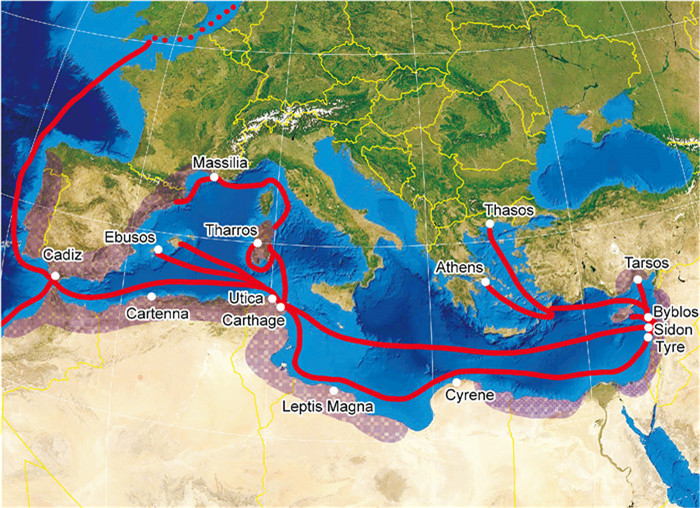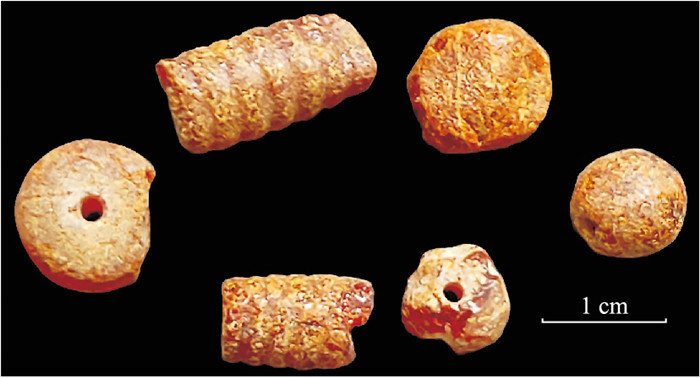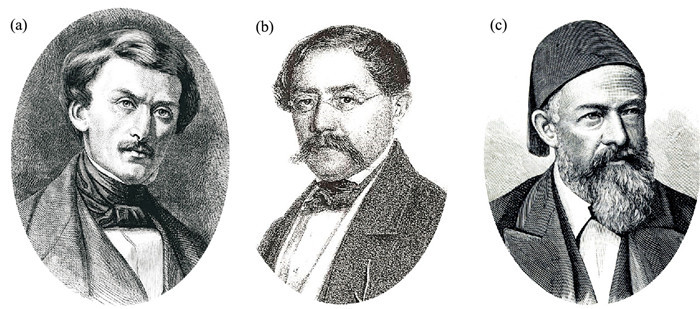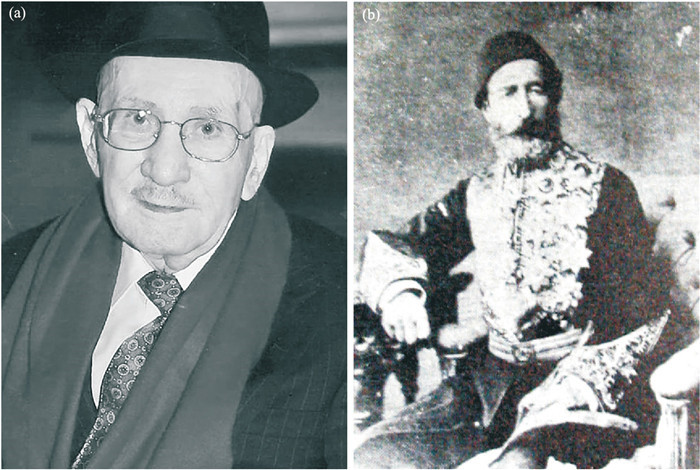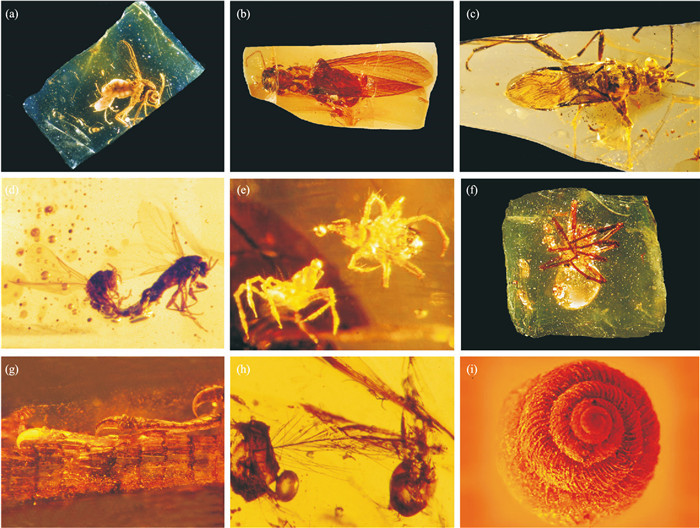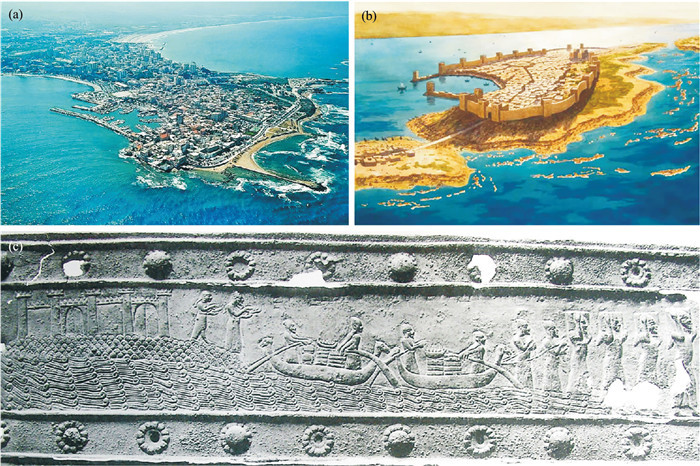
(a) Tyre during the Phoenician time, as imagined by artist (500 Questions, 2023); (b) Tyre today (Nsf2003, n.d.); (c) Ancient depiction of the fortified island city of Tyre, circa 837 B.C., illustrating its walls and towers (Evidence-For-The-Bible, n.d.).
Figures of the Article
-
![]() Map showing all Late Jurassic amber localities in Lebanon. Yellow dots represent the discovered outcrops. 1: El-Ghineh; 2: Ehmej-Aalmat; 3: Qartaba; 4: Tannourine El-Faouqa; 5: Harissa; 6: Ed-Doueir; 7: Arz Tannourine; 8: Hadath El-Joubbeh; 9: Bcharreh-Beqaa Kafra; 10: Beit Mounzer; 11: Qnaiouer; 12: Ehden (Mantra); 13: Ehden-Aaintourine; 14: Aaintourine; 15: Haouqa Ⅱ; 16: Haouqa I; 17: Haouqa Ⅲ; 18: Blaouza Ⅱ; 19:Blaouza I. (Map source is public and provided by Google Earth).
Map showing all Late Jurassic amber localities in Lebanon. Yellow dots represent the discovered outcrops. 1: El-Ghineh; 2: Ehmej-Aalmat; 3: Qartaba; 4: Tannourine El-Faouqa; 5: Harissa; 6: Ed-Doueir; 7: Arz Tannourine; 8: Hadath El-Joubbeh; 9: Bcharreh-Beqaa Kafra; 10: Beit Mounzer; 11: Qnaiouer; 12: Ehden (Mantra); 13: Ehden-Aaintourine; 14: Aaintourine; 15: Haouqa Ⅱ; 16: Haouqa I; 17: Haouqa Ⅲ; 18: Blaouza Ⅱ; 19:Blaouza I. (Map source is public and provided by Google Earth).
-
![]() Map of Lebanon with Lower Cretaceous amber and fossil insects’ outcrops. Dark green areas indicate the distribution of the amber localities. Yellow circular spots indicate the emplacements of Lower Cretaceous amber outcrops with insects’ inclusions: (1) Mechmech (Ain El-Khyar); (2) Nimrin (El-Dabsheh); (3) Brissa; (4) near Bcharreh; (5) Beqaa Kafra; (6) Hadath El-Joubbeh; (7) Tannourine; (8) Mazraat Kfardibiane; (9) Ouata El-Jaouz; (10) Bqaatouta (El-Shqif); (11) Baskinta (Qanat Bakish); (12) Daychouniyyeh; (13) Kfar Selouan; (14) Kfar Selouan (Khallet Douaiq); (15) Mdeyrij-Hammana; (16) Falougha; (17) Ain Zhalta; (18-19) Ain Dara (two localities); (20) Sarhmoul; (21) Roum-Aazour-Homsiyeh; (22) Bkassine (Jouar Es-Souss); (23) Wadi Jezzine; (24) Maknouniyeh; (25) Rihane; (26) Esh-Sheaybeh; (27) Bouarij; (28) Aita El-Foukhar; (29) Ain Zhalta (Ain Azimeh); (30) Tannoura.
Map of Lebanon with Lower Cretaceous amber and fossil insects’ outcrops. Dark green areas indicate the distribution of the amber localities. Yellow circular spots indicate the emplacements of Lower Cretaceous amber outcrops with insects’ inclusions: (1) Mechmech (Ain El-Khyar); (2) Nimrin (El-Dabsheh); (3) Brissa; (4) near Bcharreh; (5) Beqaa Kafra; (6) Hadath El-Joubbeh; (7) Tannourine; (8) Mazraat Kfardibiane; (9) Ouata El-Jaouz; (10) Bqaatouta (El-Shqif); (11) Baskinta (Qanat Bakish); (12) Daychouniyyeh; (13) Kfar Selouan; (14) Kfar Selouan (Khallet Douaiq); (15) Mdeyrij-Hammana; (16) Falougha; (17) Ain Zhalta; (18-19) Ain Dara (two localities); (20) Sarhmoul; (21) Roum-Aazour-Homsiyeh; (22) Bkassine (Jouar Es-Souss); (23) Wadi Jezzine; (24) Maknouniyeh; (25) Rihane; (26) Esh-Sheaybeh; (27) Bouarij; (28) Aita El-Foukhar; (29) Ain Zhalta (Ain Azimeh); (30) Tannoura.
-
![]() Trade (maritime road) in the ancient Mediterranean between 8th and 4th centuries BC. The regions shaded in purple were under the Phoenician influence. (Map source is public and provided by Wikipedia).
Trade (maritime road) in the ancient Mediterranean between 8th and 4th centuries BC. The regions shaded in purple were under the Phoenician influence. (Map source is public and provided by Wikipedia).
-
![]() Amber beads from Roman times found in different archaeological sites in Beirut and Beqaa valley.
Amber beads from Roman times found in different archaeological sites in Beirut and Beqaa valley.
-
![]() (a) Tyre during the Phoenician time, as imagined by artist (500 Questions, 2023); (b) Tyre today (Nsf2003, n.d.); (c) Ancient depiction of the fortified island city of Tyre, circa 837 B.C., illustrating its walls and towers (Evidence-For-The-Bible, n.d.).
(a) Tyre during the Phoenician time, as imagined by artist (500 Questions, 2023); (b) Tyre today (Nsf2003, n.d.); (c) Ancient depiction of the fortified island city of Tyre, circa 837 B.C., illustrating its walls and towers (Evidence-For-The-Bible, n.d.).
-
![]() (a) The Melqart stele (National Museum of Aleppo), also known as the Ben-Hadad or Bir-Hadad stele, is an Aramaic stele created during the 9th century; (b) Roman Emperor Elagabalus (218-222 AD); (c) Roman Emperor Gordian III (238-244 AD); (d) Roman Emperor Trebonianus Gallus (251-253 AD); (e) Roman Emperor Valerian I (253-290 AD); (f) and (g) Roman coin minted in Tyre under the reign of Emperor Elagabalus (218-222 AD), Æ 27 mm; (h) Roman coin minted in Tyre under the reign of Emperor Gordian III (238-244 AD), Æ 29 mm; (i) Roman coin minted in Tyre under the reign of Emperor Gordian III (238-244 AD), Æ29 mm; (j) Roman coin minted in Tyre under the reign of Emperor Trebonianus Gallus (251-253 AD), Æ25 mm; (k) Roman coin minted in Tyre under the reign of Emperor Valerian I (253-290 AD), Æ27 mm. The reverses of all those coins represent the mythological foundation of the City of Tyre (in Southern Lebanon), as reported in the Dionysiaka by Nonnos of Panopolis.
(a) The Melqart stele (National Museum of Aleppo), also known as the Ben-Hadad or Bir-Hadad stele, is an Aramaic stele created during the 9th century; (b) Roman Emperor Elagabalus (218-222 AD); (c) Roman Emperor Gordian III (238-244 AD); (d) Roman Emperor Trebonianus Gallus (251-253 AD); (e) Roman Emperor Valerian I (253-290 AD); (f) and (g) Roman coin minted in Tyre under the reign of Emperor Elagabalus (218-222 AD), Æ 27 mm; (h) Roman coin minted in Tyre under the reign of Emperor Gordian III (238-244 AD), Æ 29 mm; (i) Roman coin minted in Tyre under the reign of Emperor Gordian III (238-244 AD), Æ29 mm; (j) Roman coin minted in Tyre under the reign of Emperor Trebonianus Gallus (251-253 AD), Æ25 mm; (k) Roman coin minted in Tyre under the reign of Emperor Valerian I (253-290 AD), Æ27 mm. The reverses of all those coins represent the mythological foundation of the City of Tyre (in Southern Lebanon), as reported in the Dionysiaka by Nonnos of Panopolis.
-
![]() (a) Paul-Émile Botta, a French archaeologist (1802-1870)(Ashurbanipal Library Project, 2013); (b) Joseph Russegger (or Joseph Ritter von Russegger), an Austrian geologist (1802-1863)(Austria-Forum, 2011); (c) Oscar Fraas (or Oscar Friedrich von Fraas), a German geologist (1824-1897)(Wikimedia Commons., n.d.)
(a) Paul-Émile Botta, a French archaeologist (1802-1870)(Ashurbanipal Library Project, 2013); (b) Joseph Russegger (or Joseph Ritter von Russegger), an Austrian geologist (1802-1863)(Austria-Forum, 2011); (c) Oscar Fraas (or Oscar Friedrich von Fraas), a German geologist (1824-1897)(Wikimedia Commons., n.d.)
-
![]() (a) Professor Aftim Acra (1922-2007), photo from Reem Acra; (b) Rustem Pasha (or Rustem Mariani, 1810-1885), the Italian governor of Mount Lebanon (1873-1883)(Wikipedia, 2022, October 6)
(a) Professor Aftim Acra (1922-2007), photo from Reem Acra; (b) Rustem Pasha (or Rustem Mariani, 1810-1885), the Italian governor of Mount Lebanon (1873-1883)(Wikipedia, 2022, October 6)
-
![]() (a) Jurassic amber from Aaintourine; (b) Jurassic amber from Beit Mounzer.
(a) Jurassic amber from Aaintourine; (b) Jurassic amber from Beit Mounzer.
-
![]() (a) Early Cretaceous amber from the newly discovered (17th April 2023) fossiliferous outcrop of Tannoura; (b) Early Cretaceous amber from the fossiliferous amber outcrop of Aita El-Foukhar.
(a) Early Cretaceous amber from the newly discovered (17th April 2023) fossiliferous outcrop of Tannoura; (b) Early Cretaceous amber from the fossiliferous amber outcrop of Aita El-Foukhar.
-
![]() (a) A Chironomidae dipteran (non-biting midge) parasitized by an Acari (in the abdomen); (b) Lebanotermes veltzae Engel, Azar & Nel, 2011, Isoptera (termite), the oldest social insect in amber; (c) Yuripopovina magnifica Azar et al., 2011, a representative of the pentatomomorphan extinct family of Yuripopovinidae; (d) Scatopsidae dipterans in copula, the oldest preserved mating pair in amber; (e) The oldest Acari in amber; (f) The oldest Liniphiidae spider in amber; (g) Baabdasaurus xenorus, Arnolds et al., 2002, the oldest reptile in amber; (h) The oldest feather in amber; (i) The oldest pupillid snail.
(a) A Chironomidae dipteran (non-biting midge) parasitized by an Acari (in the abdomen); (b) Lebanotermes veltzae Engel, Azar & Nel, 2011, Isoptera (termite), the oldest social insect in amber; (c) Yuripopovina magnifica Azar et al., 2011, a representative of the pentatomomorphan extinct family of Yuripopovinidae; (d) Scatopsidae dipterans in copula, the oldest preserved mating pair in amber; (e) The oldest Acari in amber; (f) The oldest Liniphiidae spider in amber; (g) Baabdasaurus xenorus, Arnolds et al., 2002, the oldest reptile in amber; (h) The oldest feather in amber; (i) The oldest pupillid snail.
-
![]() Reconstruction of the Lebanese amber forest during the Early Cretaceous.
Reconstruction of the Lebanese amber forest during the Early Cretaceous.


 Download:
Download:


